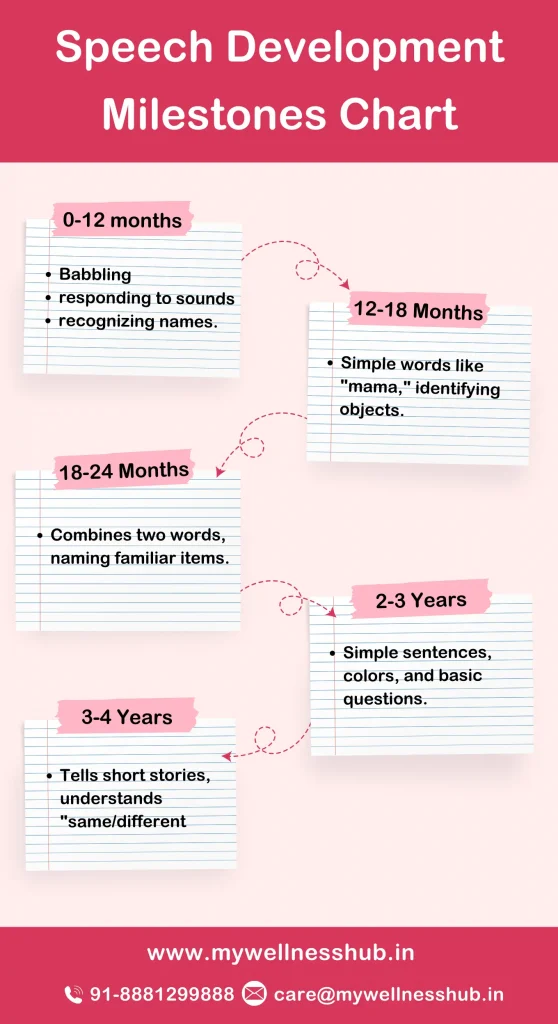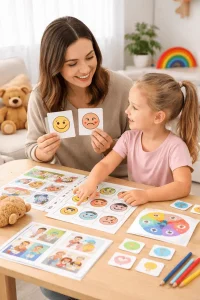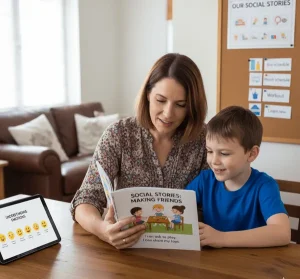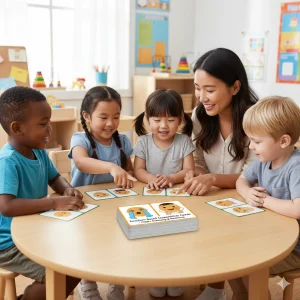Speech Therapy at Home: Simple Techniques That Really Work
Last Updated: October 14, 2024
Speech therapy at home is a powerful way for parents to support their child’s communication skills. Simple, daily techniques can complement professional sessions, boosting progress in a fun and familiar environment. Studies show that early intervention and consistent practice significantly improve language development.
Parents play a key role in making speech therapy effective—no special tools required, just a little creativity and patience. Dive in to discover practical strategies you can use today to help your child thrive. For personalized guidance, professional support is always just a step away. Let’s get started!
Why Speech Therapy at Home is Crucial
Reinforcing Professional Therapy
Home-based speech therapy activities are essential in supporting what children learn during professional sessions. Practicing regularly at home helps children retain new words, sounds, and communication strategies introduced by their therapist. By reinforcing these skills daily, parents play a significant role in accelerating their child’s progress, making each therapy session more effective.
Also Read: Speech Therapy at Home: Key Tips Every Parent Should Know
Key Benefits of Home-Based Therapy
Practicing speech therapy at home offers a range of advantages, helping parents and children make the most of therapy without adding extra stress. Below is a table that highlights the key benefits:
| Benefit | Description |
|---|---|
| Flexibility | Fits easily into family routines, allowing parents to choose times when their child is most focused. |
| Cost-Effectiveness | Reduces the need for extra sessions, making therapy more affordable. |
| Personalized Learning | Parents can tailor activities to their child’s interests, enhancing engagement and motivation. |
| Familiar Environment | Practicing at home reduces anxiety, helping children feel comfortable and focused. |
Understanding Your Child’s Speech and Language Needs

Developmental Milestones
Recognizing speech and language milestones can help you understand your child’s progress and identify areas where they may need support. Here’s a quick look at typical milestones for different ages:
| Age Range | Speech & Language Milestones |
|---|---|
| 0-12 months | Responds to sounds, babbles, and recognizes names. |
| 12-18 months | Says simple words like “mama” or “dada,” and starts to name familiar objects. |
| 18-24 months | Combines two words (e.g., “want cookie”), names objects, and points to body parts. |
| 2-3 years | Forms 2-3 word sentences, identifies colors, and starts asking simple questions. |
| 3-4 years | Tells short stories, follows multi-step instructions, and understands concepts like “same” and “different.” |
Tracking these milestones can help you spot areas for early support if needed.
Identifying Speech Delays
Early signs of a speech delay may include unclear speech, difficulty following instructions, or visible frustration while communicating. Look out for these potential indicators:
- Limited vocabulary for their age
- Difficulty understanding simple directions
- Lack of response to their name
- Struggling to form sentences or express ideas
Top Techniques for Effective Speech Therapy at Home

1. Complete the Thought Game
This game encourages your child to practice sentence formation and expand their vocabulary. To play, start a sentence and let your child finish it. For example, say, “Today, I went to the…” and allow your child to complete the thought. If they say, “park,” respond by repeating, “Today, I went to the park.” This helps children build confidence in creating sentence.
Example:
Parent: “This morning, I had a big…”
Child: “Breakfast!”
Parent: “Yes! I had a big breakfast. What did you have for breakfast?”
By actively engaging in storytelling, children feel more comfortable expressing themselves.
2. Use Flashcards
Flashcards are an excellent way to introduce new vocabulary and help children associate words with objects. Start with familiar objects, such as animals flash cards or household items. Show a card, say the name of the object, and encourage your child to repeat it.
For easy access to downloadable and printable flashcards, explore Wellness Hub’s speech therapy resources. These can be particularly effective when introducing specific speech sounds or building vocabulary.
Tips:
- Begin with a small set of familiar objects.
- Use clear, simple images on the flashcards.
- Focus on one sound or category at a time to avoid confusion.
3. Read with Your Child
Reading together is a powerful way to build language skills. Choose books that are appropriate for your child’s age and focus on clear, repetitive language. During reading time, ask questions like, “What do you think will happen next?” or “Can you find the cat in the picture?” Emphasize keywords as you read to help with pronunciation and comprehension.
Tips for Choosing Books:
- For toddlers, select books with large, colorful images and simple text.
- For preschoolers, choose books with rhyming words or familiar stories that encourage interaction.
4. Model Simple Language
Children learn by imitating, so modeling clear, simple language is essential. Hold up an object and name it, encouraging your child to repeat after you. For example, say, “This is a ball. Can you say ball?” This technique helps children associate objects with words and builds their vocabulary.
Tips:
- Use short, clear sentences.
- Repeat new words several times in different contexts to reinforce learning.
- Maintain eye contact and speak slowly to encourage your child to focus on how you pronounce each word.
5. Play Interactive Games
Games like “Simon Says,” blowing through straws, or memory games add fun to speech practice. Blowing through straws, for example, helps strengthen mouth muscles, which are essential for speech clarity. Memory games, on the other hand, improve recall skills and vocabulary.
Game Ideas:
- Simon Says: Encourages listening and following instructions.
- Straw Blowing: Strengthens oral muscles—challenge your child to blow a ping-pong ball through a “goal.”
- I-Spy: Builds vocabulary and description skills by asking them to find items around the house.
6. Provide Choices to Build Language
Presenting choices encourages your child to use language to express preferences. For example, ask, “Do you want juice or milk?” This technique helps children learn decision-making and descriptive language.
Example:
Parent: “Do you want to wear the blue shirt or the red shirt?”
Child: “Red shirt.”
Read more about Top Speech Therapy Techniques for Parents to Use at Home
How to Create a Speech Therapy-Friendly Environment at Home
1. Choosing the Right Space
Selecting a quiet, distraction-free zone is essential for effective speech practice. Find a corner or room in your home where your child can focus without background noise from the TV, other devices, or high foot traffic. A calm environment allows your child to concentrate better, making each session more productive and enjoyable.
2. Stocking the Space with Tools
Having the right speech therapy tools readily available makes each therapy session smoother and keeps your child engaged. Essential items include:
- Flashcards: Great for vocabulary building and sound practice.
- Books: Choose simple, engaging storybooks that encourage language development.
- Interactive Toys: Toys like puzzles or building blocks can make learning feel like playtime.
- Props like Puppets or Stuffed Animals: These can be used for role-play activities that make speech exercises fun and imaginative.
3. Consistency in Routines
Setting up a routine by practicing in the same space daily helps reinforce the importance of these sessions. When your child knows where therapy happens, they’ll begin to associate that spot with learning, which can improve their focus and cooperation. Try to practice at the same time each day, making it a part of your child’s routine.
A consistent, well-prepared environment gives your child the foundation they need to make the most of their speech therapy at home.
Common Mistakes to Avoid in Speech Therapy at Home
To make speech therapy effective and enjoyable for your child, avoid these common pitfalls:
- Overcorrecting Your Child
Correcting every mistake can create stress and frustration. Instead, model the correct way to say words and allow your child to learn naturally through repetition. - Rushing Progress
Speech development takes time. Each child progresses at their own pace, so be patient and celebrate small achievements rather than expecting immediate results. - Lack of Consistency
Inconsistent practice can slow progress. Try to integrate short, daily sessions and maintain a routine to reinforce skills. - Ignoring Overall Communication Skills
Speech therapy is about more than just sounds. Focus on complete communication, including vocabulary, sentence structure, and expressive language skills. - Neglecting the Child’s Interests
Engaging your child’s interests, like favorite toys or topics, makes therapy more effective. Use activities they enjoy to keep sessions fun and engaging.
Avoiding these common mistakes helps create a positive, productive environment for your child’s speech development.
When to Seek Professional Help
Sometimes, despite consistent practice, progress may be slower than expected. Here are some signs that it might be time to consult a professional:
- No noticeable improvement after 3-6 months of home-based practice.
- Persistent difficulty with basic words or sounds appropriate for their age.
- Frustration or anxiety around communication.
- Challenges in following simple instructions or interacting with peers.
Click here to book your consultation.
Conclusion
Speech therapy at home can transform your child’s communication skills. Simple activities like games, reading, and creating a fun learning space make a big difference. With patience and regular practice, you can help your child gain confidence and improve their speech.
Parents are key to their child’s progress, and your support means everything. Celebrate small wins and don’t stress—every step matters. If you need expert advice or extra resources, Wellness Hub is here to help. Let’s work together to help your child thrive.
Frequently Asked question:
1. What is Speech Therapy at Home, and How Does it Help My Child?
Speech therapy at home involves parents and caregivers practicing speech and language exercises with their child in a familiar, comfortable environment. By reinforcing techniques learned in professional therapy, home-based activities help improve language skills, promote better communication, and build confidence in your child. It’s especially effective for children with speech delays or language disorders.
2. How Can I Tell If My Child Needs Speech Therapy?
If your child is not meeting language development milestones, such as speaking in full sentences by age 3 or having difficulty with sounds and words, it may indicate the need for speech therapy. Early signs can include unclear speech, frustration when trying to communicate, or not responding to verbal cues. Consulting a speech therapist can provide clarity and guide you on the next steps.
3. What Techniques Can I Use for Speech Therapy at Home?
There are several techniques parents can use to support their child’s speech development, including:
- Playing the Complete the Thought Game to encourage full sentences.
- Using flashcards to build vocabulary.
- Reading together daily to strengthen language skills.
- Modeling simple language and engaging in everyday conversations.
These techniques make speech practice fun and effective at home.
4. How Can I Make Speech Therapy Fun for My Child at Home?
Incorporating games and activities into speech therapy makes it more enjoyable for your child. Use interactive games like Simon Says, memory matching games, or storytelling activities. Creating a playful, encouraging atmosphere helps keep your child engaged and eager to participate in speech exercises.
5. How Long Should I Spend on Speech Therapy Exercises Each Day?
Consistency is key, but you don’t need to dedicate long hours to speech therapy at home. Spending 15-30 minutes a day on focused speech exercises can make a significant difference. Break the activities into short sessions and integrate language-building exercises into daily routines, such as mealtime or playtime.
6. What Should I Avoid When Doing Speech Therapy at Home?
Avoid overcorrecting your child or putting too much pressure on them to speak perfectly. It’s important to create a positive, supportive environment where mistakes are part of learning. Also, don’t rush the process—language development takes time, and each child progresses at their own pace. Patience and encouragement are crucial.
7. What Are the Signs That Speech Therapy at Home is Working?
Signs of progress in speech therapy include:
- Your child uses more words in conversation.
- There is an improvement in clarity and articulation.
- They are able to follow verbal instructions more easily.
- Frustration around communication decreases.
Tracking these improvements and keeping a speech journal can help you monitor progress.
8. How Can I Set Up a Speech-Friendly Environment at Home?
Creating a quiet, distraction-free space at home is ideal for speech therapy. Set up an area with tools such as flashcards, books, and interactive toys that support speech exercises. Ensure that it’s a comfortable space where your child feels safe and motivated to practice their language skills.
9. When Should I Seek Professional Help for My Child’s Speech Development?
If you notice no improvement after consistently practicing speech therapy at home for a few months, or if your child’s speech difficulties worsen, it’s essential to seek professional help. A licensed speech therapist can assess your child’s specific needs and recommend tailored interventions.
10. Why Should I Continue Speech Therapy Even After My Child Improves?
Speech therapy should continue even after noticeable improvements to solidify progress and prevent regression. Consistency helps ensure that your child’s language skills are reinforced and maintained over time. Continuing speech therapy at home allows children to build on their existing progress and reach their full communication potential.
About the Author:
Shravanaveena Gajula
M.Sc ., Speech and Language Pathology (9+ years of experience)
Shravanaveena Gajula is a dedicated Audiologist and Speech-Language Pathologist with a BASLP and an M.Sc in Speech and Language Pathology. With experience spanning multiple settings, including Wellness Hub and Ashray Akruti, Veena specializes in a wide range of disorders from developmental issues in children to speech and language assessments in adults. Her expertise includes parent counseling, managing speech sound and fluency disorders, and creating individualized therapy programs. Veena is also PROMPT certified and an author of several insightful blogs on speech and language pathology, aiming to educate and assist caregivers in supporting their loved ones.
Book your Free Consultation Today
Parent/Caregiver Info:
Client’s Details:
* Error Message









